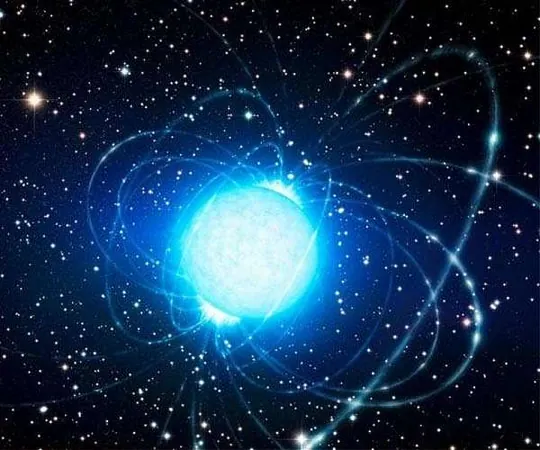
Groundbreaking Study Links Fast Radio Bursts to Neutron Stars, Unlocking Cosmic Mysteries
2025-01-03
Author: Li
Introduction
In a groundbreaking revelation that could redefine our understanding of the universe, an international team of researchers from McGill University has solidified the connection between fast radio bursts (FRBs) and neutron stars—extremely dense remnants of massive stars that end their lives in cataclysmic supernova explosions. This pivotal discovery, emerging from a meticulous analysis of a single FRB, sheds vital light on the enigmatic radio signals that have baffled astronomers for over a decade.
Research Details
Ryan Mckinven, a doctoral researcher at McGill's Department of Physics and the lead author of the study published in *Nature*, stated, "This result reaffirms long-held suspicions about the connection between FRBs and neutron stars. However, our findings also challenge popular theoretical models, indicating that the radio emission occurs much closer to the neutron star than previously assumed."
Observations and Analysis
FRBs release an astonishing amount of energy in mere milliseconds—equivalent to what our sun emits in an entire day. Since their first discovery in 2007, thousands have been recorded, but their origins have remained elusive. Utilizing the Canadian Hydrogen Intensity Mapping Experiment (CHIME) radio telescope, Mckinven and his team noticed remarkable similarities between the behaviors of FRBs and pulsars, a well-established category of neutron stars known for their radio emissions.
By examining the FRB's polarization—a characteristic of radio waves that relates to their direction of oscillation—the researchers observed a dramatic shift in the polarization angle over a brief 2.5-millisecond duration. This rare trait, typically associated with pulsars, prompted initial thoughts that the signal might originate from a misclassified pulsar within our Milky Way galaxy. However, further investigation clarified that the signal came from a distant galaxy millions of light-years away.
Importance of Polarimetry
"Polarimetry serves as one of the few tools we have to explore these remote sources," explained Mckinven. "Our results are likely to inspire extensive follow-up studies on similar behaviors in other FRBs, leading to theoretical efforts that will reconcile their polarized signals with our findings.”
Role of the CHIME Telescope
The vital role of the CHIME telescope cannot be overstated. Located in Penticton, British Columbia, CHIME captures thousands of FRBs each day, providing scientists with a unique opportunity to detect rare signals such as this one. Mckinven remarked, "This is a step closer to unraveling a profound cosmic mystery. FRBs are everywhere, yet their true nature remains largely elusive. Each new discovery about their origins opens fresh avenues into the dynamics of our universe."
Complementary Research
Complementary research led by Kenzie Nimmo at the Massachusetts Institute of Technology reinforced the neutron star hypothesis. Nimmo’s findings revealed that this particular FRB exhibited scintillation—a twinkling effect reminiscent of how stars appear in the night sky. "This scintillation indicates that the region where the FRB originated must be incredibly small," Nimmo explained. "We've pinpointed the emission site to less than 10,000 kilometers, despite it being over 200 million light-years away. This remarkable precision suggests that the FRB arises from the intensely magnetic environment surrounding a neutron star, one of the universe's most extreme environments."
Conclusion
Aaron Pearlman, a Banting Prize Postdoctoral Fellow at McGill's Department of Physics and the Trottier Space Institute, highlighted the significance of these studies. "The scintillation pattern and polarization angle swing we observed aligns with the expected behavior for a supergiant radio pulse emitted near a highly magnetized, rotating neutron star. Our findings present compelling evidence that some FRBs could indeed be generated by neutron stars."
This monumental research not only advances our understanding of those fleeting, high-energy signals known as FRBs but also paves the way for future explorations of extreme astrophysical phenomena. As scientists continue to probe the depths of these cosmic mysteries, the quest for knowledge about our universe and its origins becomes all the more thrilling!

 Brasil (PT)
Brasil (PT)
 Canada (EN)
Canada (EN)
 Chile (ES)
Chile (ES)
 Česko (CS)
Česko (CS)
 대한민국 (KO)
대한민국 (KO)
 España (ES)
España (ES)
 France (FR)
France (FR)
 Hong Kong (EN)
Hong Kong (EN)
 Italia (IT)
Italia (IT)
 日本 (JA)
日本 (JA)
 Magyarország (HU)
Magyarország (HU)
 Norge (NO)
Norge (NO)
 Polska (PL)
Polska (PL)
 Schweiz (DE)
Schweiz (DE)
 Singapore (EN)
Singapore (EN)
 Sverige (SV)
Sverige (SV)
 Suomi (FI)
Suomi (FI)
 Türkiye (TR)
Türkiye (TR)
 الإمارات العربية المتحدة (AR)
الإمارات العربية المتحدة (AR)